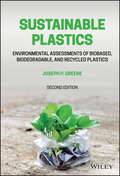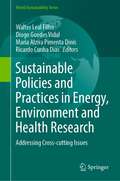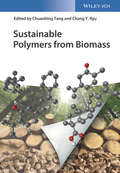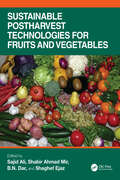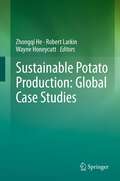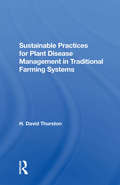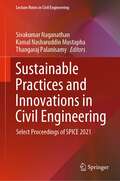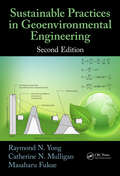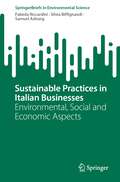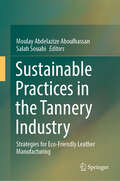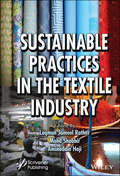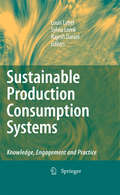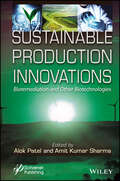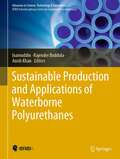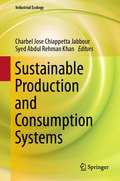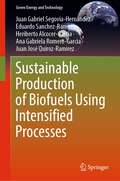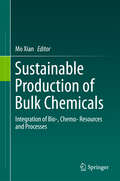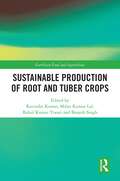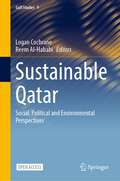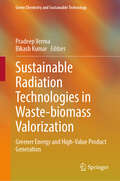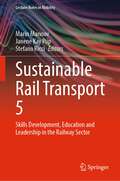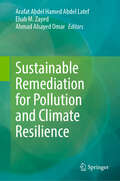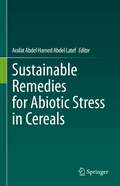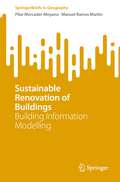- Table View
- List View
Sustainable Plastics: Environmental Assessments of Biobased, Biodegradable, and Recycled Plastics
by Joseph P. GreeneEnables Readers to Understand the What, Why, and How Behind Using Sustainable Plastics in Manufacturing Operations The impact of 50 years of unbridled plastics production, use, and disposal is now becoming well known and documented. Plastics made from non-renewable petroleum and natural gas resources threaten the environment, human health, species maintenance, and the very life of the ocean. This book helps readers understand the ability of plastics to be sustainable and goes over the plastic products which have a lower carbon footprint, lower waste, and lower pollution. The well-qualified author&’s unique perspective puts a special focus on comprehensive coverage of environmental impacts of plastics including Life Cycle Assessments (LCA) and sustainability strategies related to biobased plastics (e.g., corn), recycled plastics, and petroleum-based plastics. Other samples topics covered in the book include: End-of-life options for petroleum and biobased plastics including mechanical recycling, chemical recycling, and composting ASTM biodegradation standards for compost, marine, anaerobic digestion, and landfill environments Polymer processing, including injection molding, blow molding, extrusion, and compression molding Environmental data and coverage of petroleum plastics, sustainable composites, and new information on bio-based plasticsThe book serves as an invaluable resource for plastics engineers, materials engineers, and all professionals in related disciplines looking to understand and apply the usage of sustainable plastics in many different types of manufacturing operations.
Sustainable Policies and Practices in Energy, Environment and Health Research: Addressing Cross-cutting Issues (World Sustainability Series)
by Walter Leal Filho Diogo Guedes Vidal Maria Alzira Pimenta Dinis Ricardo Cunha DiasThis book aims to give a contribution to a more comprehensive and interdisciplinary understanding of the cross-cutting issues on energy, environment and health research topics in the current world scenario, where nations all over the world are struggling to accomplish the United Nations Sustainable Development Goals and to ensure sustainable patterns for all. This interdisciplinary implies a commitment between all fields of science, working together to provide knowledge that could result in the promotion of quality of life. At the present, it is evident that not all people benefit from sustainable policies and practices and the communication between health, energy, environmental and social problems is undeniable. A call for different views could be a pathway attracting universities, stakeholders, organizations and civil society to deeply discuss how one solution does not fit all societies. Few publications are coherently handling this matter. This book is expected to fill this gap and to develop an interest in a larger audience working in general sustainable development and cross-cutting issues. This book is produced by the European School of Sustainability Science and Research (ESSSR). It gives special emphasis to state-of-the-art descriptions of approaches, methods, initiatives and projects from universities, stakeholders, organizations and civil society across the world, regarding cross-cutting issues in energy, environment and health research.
Sustainable Polymer Composites and Nanocomposites
by Sabu Thomas Inamuddin Abdullah M. Asiri Raghvendra Kumar MishraThis book presents emerging economical and environmentally friendly polymer composites that are free of the side effects observed in traditional composites. It focuses on eco-friendly composite materials using granulated cork, a by-product of the cork industry; cellulose pulp from the recycling of paper residues; hemp fibers; and a range of other environmentally friendly materials procured from various sources. <p><p> The book presents the manufacturing methods, properties and characterization techniques of these eco-friendly composites. The respective chapters address classical and recent aspects of eco-friendly polymer composites and their chemistry, along with practical applications in the biomedical, pharmaceutical, automotive and other sectors. Topics addressed include the fundamentals, processing, properties, practicality, drawbacks and advantages of eco-friendly polymer composites. <p> Featuring contributions by experts in the field with a variety of backgrounds and specialties, the book will appeal to researchers and students in the fields of materials science and environmental science. Moreover, it fills the gap between research work in the laboratory and practical applications in related industries.
Sustainable Polymers from Biomass
by Chang Y. Ryu Chuanbing TangOffering a unique perspective summarizing research on this timely important topic around the globe, this book provides comprehensive coverage of how molecular biomass can be transformed into sustainable polymers. It critically discusses and compares a few classes of biomass - oxygen-rich, hydrocarbon-rich, hydrocarbon and non-hydrocarbon (including carbon dioxide) as well as natural polymers - and equally includes products that are already commercialized. A must-have for both newcomers to the field as well as established researchers in both academia and industry.
Sustainable Postharvest Technologies for Fruits and Vegetables
by Shabir Ahmad Mir B. N. Dar Sajid Ali Shaghef EjazFruits and vegetables, commonly termed as "fresh produce" are an important component of the human diet, as these provide various beneficial and essential health-related compounds. Nevertheless, fresh produce is susceptible to postharvest deterioration and decay along with loss of certain nutrients due to innapropriate storage conditions and lack of standard postharvest technologies. In addition, the short shelf life is considered another major constraint that must be extended after harvest to ensure a wider availability window of the fresh produce for consumers. From this perspective, the use of postharvest approaches is considered imperative to reduce the deterioration of harvested fresh produce in order to extend their storage and shelf life potential on a sustainable basis. Sustainable Postharvest Technologies for Fruits and Vegetables covers various aspects of postharvest technologies with major developments over the recent past and provides a way forward for the future.The sustainable use of various technologies and elicitors could be adapted from farm to fork in order to conserve the eating quality of fresh produce. Therefore, this book covers various sustainable postharvest treatments and technologies that could be considered highly effective for the delay of postharvest senescence and deterioration. Among the various technologies, the use of preharvest treatments, controlled atmosphere, dynamic control atmosphere, modified atmosphere and hypobaric conditions has tremendous potential for the fresh fruits and vegetables industry. In the same way, cold plasma, pulsed light, ultraviolet light, ultrasound technology, nanoemulsions, nano-packaging, electrolyzed water, high pressure processing, ozone gas, irradiations, edible coatings, vacuum packaging and active packaging with slow releasing compounds along with nanotechnology are highly practicable and possesses tremendous potential to be used in the maintenance of overall eating quality and storage life extension of the fresh produce.Key Features: Overviews the major factors affecting postharvest physiology and shelf life potential of fresh produce. Focuses on major sustainable technologies having the potential to maintain postharvest quality and extend shelf life of fruits and vegetables. Describes practical and recent advances of various approaches indispensable for the maintenance of overall eating quality and food safety attainment for fresh produce on a sustainable basis. Covers how quality maintenance and shelf life rely on preharvest practices, nonthermal treatments, storage atmospheres, packaging materials, active packaging, edible packaging, coating application techniques, nanotechnology and ecofriendly plant extracts and natural antagonists.
Sustainable Potato Production: Global Case Studies
by Zhongqi He Wayne Honeycutt Robert LarkinPotato (Solanum tuberosum L.) is grown in over 100 countries throughout the world. As a staple food, potato is the fourth most important crop after rice, wheat, and maize, and has historically contributed to food and nutrition security in the world. Global interest in potato increased recently as world food prices soared, threatening the global food security and stability. Unlike major cereals, potato is not a globally traded commodity, and prices are usually determined by local production costs. Thus, potato is increasingly regarded as a vital food-security crop and as a substitute for costly cereal imports. With such importance, the 29 chapters in the edited book address the issues of sustainable potato production. This book begins with an introduction on sustainable potato production and global food security, and then presents eight case studies selected globally and covering different issues relevant to sustainable potato production in both developed and developing countries.
Sustainable Practices For Plant Disease Management In Traditional Farming Systems
by H. David ThurstonMost scientists and many of the world's farmers have abandoned traditional farming practices and systems in an effort to increase production and to improve the efficiency of land and labor use. The resulting "modern" systems largely ignore many of the sustainable pest management practices that have evolved among farmers over centuries. In this book
Sustainable Practices and Innovations in Civil Engineering: Select Proceedings of SPICE 2021 (Lecture Notes in Civil Engineering #179)
by Sivakumar Naganathan Kamal Nasharuddin Mustapha Thangaraj PalanisamyThis book presents the select proceedings of the international conference on Sustainable Practices and Innovations in Civil Engineering 2021 (SPICE 2021). The topics covered include the addition and replacement of cementitious materials in concrete, thereby enhancing the strength and durability characteristics of concrete, instrumentation and testing in structural engineering, ground improvement techniques, water management, waste management, and energy efficiency and sustainability in construction. It also includes few papers in the area of environmental civil engineering and discusses key issues in the field of water resources and the impact of COVID-19 on the construction industry. This book is a valuable reference to the students, researchers, and professionals in the field of civil engineering.
Sustainable Practices in Geoenvironmental Engineering
by Raymond N. Yong Catherine N. Mulligan Masaharu FukueIn the seven years since the publication of the first edition of Sustainable Practices in Geoenvironmental Engineering, the combination of population growth and increased exploitation of renewable and non-renewable natural resources has added increased stresses on the quality and health of the geoenvironment. This is especially true when viewed in
Sustainable Practices in Italian Businesses: Environmental, Social and Economic Aspects (SpringerBriefs in Environmental Science)
by Silvia Biffignandi Fabiola Riccardini Samuel AshongThis SpringerBrief describes the development and use of a synthetic indicator to assess different degrees of sustainability adoption by economic sector and businesses size. To make this analysis a theoretical framework which involves variables common to alternative frameworks (specifically ESG, GRI and Istat) is proposed. The empirical analysis focuses on the environmental, social and economic variables of the Italian businesses. In this analysis, all three pillars of sustainability – economic, environmental, and social – are considered. The work begins with a review of business sustainability literature and a look into institutional frameworks for the development and measurement of the phenomena. Connections between businesses and the SDGs are examined and comparison of the classifications of sustainable activities defined by GRI and ESG international standards is used to define a framework to be adopted to analyse ISTAT Business Census. Selected indicator variables are aggregated with a synthetic indicator and the results are presented (this is a new proposal of a synthetic indicator useful for the type of data used and published by ISTAT – Italian National Statistical Institute), discussing pros and cons of using it. This study provides two important innovative contributions. The first one is about how to approach the theoretical framework of businesses sustainability at firms aggregated level. The basic idea to work on a set of variables common to different approaches is interesting from the interpretative point of view. The second one, is about the specific empirical analysis, i.e. the Italian businesses sustainability situation. The investigation based on this new theoretical classification/framework and the new proposed indicator provides some interesting substantive results.
Sustainable Practices in the Tannery Industry: Strategies for Eco-Friendly Leather Manufacturing
by Salah Souabi Moulay Abdelazize AboulhassanTannery operations have significant environmental impacts due to liquid, solid, and gaseous waste discharges, along with substantial consumption of resources like raw hides, energy, chemicals, and water. On average, tanneries use 50 m3 of water and 300 kg of chemicals per ton of processed hides, exacerbating global drought challenges. To mitigate these impacts, there's a critical need to rethink water management practices in the industry. This book offers an approach to decouple economic growth from resource overuse, thereby combating climate change. It guides businesses in managing the production process with a focus on recycling water and product components, such as chromium, which is highly toxic. Integrated management methods, including the application of consumption ratios and adherence to standards like ISO management systems, are highlighted. Given the complexity and cost of treatment technologies, prioritizing best practices and preventive measures is essential to reduce liquid and solid waste production. The book also underscores the advantages of clean technologies in curbing water and chemical usage. In summary, this resource empowers tanneries to operate more efficiently and sustainably, fostering responsible economic development.
Sustainable Practices in the Textile Industry
by Mohd Shabbir Luqman Jameel Rather Aminoddin HajiThe increasing environmental and health concerns owing to the use of large quantities of water and hazardous chemicals in conventional textile finishing processes has lead to the design and development of new dyeing strategies and technologies. Sustainable Practices in the Textile Industry comprises 13 chapters from various research areas dealing with the application of different sustainable technologies for enhancing the dyeing and comfort properties of textile materials with substantial reduction in wastewater problems. Chapters focus on the sophisticated methods for improving dye extraction and dyeing properties which will minimize the use of bioresource products. This book also brings out the innovative ways of wet chemical processing to alleviate the environmental impacts arising from this sector. This book also discusses innovations in eco-friendly methods for textile wet processes and applications of enzymes in textiles in addition to the advancements in the use of nanotechnology for wastewater remediation.
Sustainable Production Consumption Systems: Knowledge, Engagement and Practice
by Sylvia Lorek Rajesh Daniel Louis LebelSustainable Production Consumption Systems brings together a set of designed case studies intended to provide a more in-depth understanding of challenges and opportunities in bringing knowledge and actions closer together for the sustainable management of specific production and consumption systems. The case study approach enabled researchers to engage directly with some of the actors involved in the production, consumption or regulation of specific goods or services and other stakeholders affected by those processes. Such engagement was particularly worthwhile when it helped mobilize actors to pursue linking knowledge with action in ways that improve the prospects for sustainability.
Sustainable Production Innovations: Bioremediation and Other Biotechnologies
by Alok Kumar Patel Amit Kumar SharmaSUSTAINABLE PRODUCTION INNOVATIONS Presenting the latest technologies and practices in this ever-changing field, this groundbreaking new volume covers the gambit for providing solutions and practical applications of smart and efficient energy systems. The global and climate changes we are witnessing are primarily driven by factors such as rising population, economic growth, and industrialization. These changes have led to an increase in atmospheric CO2, pollution, deforestation, water scarcity, and hunger, among other pressing issues. To ensure a green and sustainable future, it is crucial to harness renewable resources for the production of fuels, chemicals, and materials. The book, Sustainable Production Innovations, addresses several bioprocesses that are integral to our daily lives, tackling important topics such as biofuel production, energy and food security, and wastewater management. The commercial interest in biotechnological processes has grown significantly due to their ability to utilize biocatalysts such as enzymes, bacteria, plant cells, or animal cells in bioreactors for the production of medications, health supplements, foods, biofuels, and chemicals. Switching to bioproducts offers key benefits such as the sustainability of third-generation biofuels, CO2 sequestration, effective waste utilization, and meeting the increasing demand for clean water. The book explores various procedures used in biomass biorefineries and bioprocessing for the production of biofuels, biobased chemicals, and bioproducts. It also delves into advancements in utilizing oleaginous microorganisms for biofuels and nutraceuticals, biological wastewater treatment, and microplastic detection techniques in water. Additionally, the book covers topics such as biolubricant technologies, bioprocessing of agricultural and forest waste, biotechnological approaches in the cosmetic industry, and large-scale applications of nanomaterials for water treatment. Authored by experts from leading biotechnology research groups around the world, the book comprises 13 chapters featuring the latest research in each subject. It is a valuable resource for scholars in chemical engineering, applied microbiology, biotechnology, agricultural biotechnology, environmental biotechnology, and related fields, offering new insights into the sustainable use of renewable energy and biochemicals. Professionals, including biochemical engineers, phycologists, bioprocess engineers, chemical engineers, scientists, and researchers in the water, food, pharmaceutical, and renewable energy industries will find this book beneficial. Likewise, students and faculty in the chemical engineering and energy departments will gain valuable knowledge from its contents.
Sustainable Production and Applications of Waterborne Polyurethanes (Advances in Science, Technology & Innovation)
by Inamuddin Anish Khan Rajender BoddulaThis edited book compiles all category viewpoints in waterborne polyurethanes (WPUs) dispersions, composites, characterizing techniques, and allied applications such as coatings, adhesives, sealants, anticorrosive, flame-retardant, and biomedical applications. The book brings together panels of highly accomplished experts in the field of advanced polymers for versatile applications. It encompasses basic studies and addresses topics of novel issues which cover all the aspects in one place. The book is an invaluable guide to newcomers, research scholars, professors, and R&D industrial experts working in the field of polyurethane chemistry. Polyurethanes are excellent materials in coating technology owing to their chemical resistance, toughness, abrasion resistance, and mechanical stability. However, polyurethane dispersion contains volatile organic compounds (VOCs) and hazardous air pollutants (HAPs) which are harmful to the environment. Hence, green chemistry research focuses on discovery of waterborne polyurethanes (WPUs) and pay attention. WPUs have fascinated growing interest in wide range of industrial and commercial applications.
Sustainable Production and Consumption Systems (Industrial Ecology)
by Syed Abdul Rehman Khan Charbel Jose Chiappetta JabbourThis book opens up a critical dimension to the field of industrial ecology. The book discusses the post COVID-19 trends in the field of industrial ecology and evolving practices adopted by firms for betterment of environment and society. The authors identify valuable lessons to be learned and present conceptual frameworks to guide future industrial ecology applications. Transforming industrial systems into closed-loop industrial ecosystems dramatically reduces the negative impact of industrial activities on the environment. Therefore, this book is important not only for operation management scholars but also those who are interested in ensuring an environmentally sustainable future.
Sustainable Production of Biofuels Using Intensified Processes (Green Energy and Technology)
by Juan Gabriel Segovia-Hernández Eduardo Sanchez-Ramirez Heriberto Alcocer-Garcia Ana Gabriela Romero-Garcia Juan José Quiroz-RamirezThis book describes for first time the synthesis and intensified process design in the production of top biofuels. The production of biofuels is not new. In 2019, global biofuel production levels reached 1,841 thousand barrels of oil equivalent per day, in stark comparison to the 187 thousand barrels of oil equivalent per day that was produced in 2000. Growth has largely been driven by policies that encourage the use and production of biofuels due to the perception that it could provide energy security and reduce greenhouse gas emissions in relevant sectors. From a technical point of view, almost all fuels from fossil resources could be substituted by their bio-based counterparts. However, the cost of bio-based production in many cases exceeds the cost of petrochemical production. Also, biofuels must be proven to perform at least as good as the petrochemical equivalent they are substituting and to have a lower environmental impact. The low price of crude oil acted as a barrier to biofuels production and producers focussed on the specific attributes of biofuels such as their complex structure to justify production costs. Also, the consumer demand for environmentally friendly products, population growth and limited supplies of non-renewable resources has now opened new windows of opportunity for biofuels. The industry is increasingly viewing chemical production from renewable resources as an attractive area for investment. This book uniquely introduces the application of new process intensification techniques that will allow the generation of clean, efficient and economical processes for biofuels in a competitive way in the market.
Sustainable Production of Bulk Chemicals
by Mo XianThe book describes in detail the authors' current understanding of the models that incorporate the concepts andtechniques of synthetic chemistry, chemical engineering, synthetic biology andbioengineering. These include chemical engineering methods for green chemicalproduction from sustainable bio-resources; using synthetic chemistry andkinetics of chemical reaction concepts in the construction of non-natural enzymesand bio-pathways, partial integration of bioconversion steps in chemicalsynthesis routes; integration of chemo-, bio- conversion steps in one system;microbial production of chemicals from economic chemo-resourced chemicals; andchemical production of value-added derivatives from bio-based amino acids. It providesa valuable reference source for laboratory and industrialprofessionals in a number of chemical and biological disciplines such assynthetic chemistry, synthetic biology, chemical engineering, biotechnology,microbiology, molecular biology, etc. Dr. Mo Xian is a Professorat Qingdao Institute of Bioenergy and Bioprocess Technology, Chinese Academy ofSciences, Qingdao, China.
Sustainable Production of Root and Tuber Crops (Earthscan Food and Agriculture)
by Ravinder Kumar Brajesh Singh Milan Kumar Lal Rahul Kumar TiwariThis book provides a comprehensive overview of the latest research and developments in the field of root and tuber crops from a sustainable production and protection perspective.With a focus on sustainable production methods, the book offers valuable insights and perspectives on how to improve the efficiency and sustainability of root and tuber crop production. This is particularly important given the increasing demand for food security and sustainable agriculture practices globally. The chapters focus on a wide range of production strategies, including soil, nutrient dynamics, nutrient management, fertilizer consumption, and cropping systems, as well as the use of modern farming techniques and technologies. With seed production and supply chains playing critical roles in cash crops like potatoes, a staple food in many countries, the volume also covers healthy seed planting material, low-cost technological intervention for quality seed production, integrated weed management for local and global perspectives, and enhancing the efficiency of small-holder farmers in the Global South. Finally, this book considers the challenges posed by pests and disease management. It describes management methods, as well as the distribution, symptoms and damage, biology, survival, and spread of each pest, and also discusses various environmentally friendly pest management strategies, such as physical, cultural, chemical, biological, host resistance, and integrated methods.This book will be of interest to students and scholars of sustainable agriculture, crop management, and plant sciences.
Sustainable Qatar: Social, Political and Environmental Perspectives (Gulf Studies #9)
by Logan Cochrane Reem Al-HababiThis open access book provides a topical overview of the key sustainability issues in Qatar, focusing on environmental sustainability from a socio-political perspective. The transition to a sustainable Qatar requires engagement with diverse areas of social-political, human, and environmental development. On the environmental aspects, the contributors address climate change, food security, water reuse and desalination, energy, and biodiversity. The socio-political section examines state strategy and regulation, the place of environmental law and geopolitics and sustainability innovators and catalysts. The human section considers economics, sustainability education, the knowledge economy, and waste management. In doing so, the book demarcates the ways in which the country encounters and grapples with significant challenges and delves into the range of options for future pathways to sustainability in Qatar. Relevant to policymakers and scholars in energy and environment, urban and developmental studies, as well as the arenas of politics, climate change and policy, this book is a landmark collection on environmental policy in the Gulf and beyond.
Sustainable Radiation Technologies in Waste-biomass Valorization: Greener Energy and High-Value Product Generation (Green Chemistry and Sustainable Technology)
by Pradeep Verma Bikash KumarThis book illustrates past and recent advances in radiation-based technologies for their application in waste biomass valorization. The radiation technologies are useful for biomass pretreatment for overcoming biomass recalcitrance or direct conversion of biomass into bio-oil or high-value products. The book demonstrates the technological aspects of several radiation-based technologies such as microwave, ultrasound, gamma, x-ray, laser, and electric field. These highly advanced cutting-edge technologies are a sustainable approach and serve the dual purpose of value addition and waste remediation. These technologies are in different stages of their development and attempts have been made to move them to large-scale applications; thus, this book focuses on the different developmental stages of each technology along with futuristic suggestions and inputs. The book not only attempts to cover technical aspects such as the design and functioning of the equipment but also covers the current industrial prospect of each technology. It addresses the bottlenecks that are challenging its growth and movement to large-scale applications and introduces the cost, market cover, and government policies for the implementation of technologies in the industries. Finally, it provides future perspectives and opportunities in irradiation-based technologies for sustainable growth of future waste biomass-based biorefinery. This book provides interdisciplinary viewpoints from multiple sciences and is helpful and valuable to a wide readership in the various fields of mechanical and chemical engineering, biophysics, bioprocessing, high-value product generation, and biorefinery.
Sustainable Rail Transport 5: Skills Development, Education and Leadership in the Railway Sector (Lecture Notes in Mobility)
by Marin Marinov Stefano Ricci Janene Kay PiipThis book offers a timely collection of chapters on innovative research and education-focused developments in the vast field of rail transport, including rail operations, management, economics, and sustainable infrastructure. Adding on the tradition of the previous four volumes, here a special emphasis is given on the current needs for rail skills development, innovating rail higher education provision, and solutions aimed at bridging the gap between railway education and industry expectations. Strategies for making the rail sector more attractive to early careers and younger generations, and methods to identify and retain talents in the railway sector are also described. Gathering peer-reviewed contributions prepared by the RailUniNet and AstonRail strategic partnership members, this book offers a timely view on current developments on rail-focused teaching and learning methods and approaches with extensive information for both academics and professionals specialising in railway research, technologies, training and education.
Sustainable Remediation for Pollution and Climate Resilience
by Arafat Abdel Hamed Abdel Latef Ehab M. Zayed Ahmad Alsayed OmarThis book offers a comprehensive exploration of strategies to combat pressing environmental challenges, focusing on pollution remediation and climate change mitigation. It presents innovative recycling models and advanced tertiary water treatment methods as viable solutions to these global issues. As humanity faces the consequences of pollution, from plastic waste to industrial contamination, this book highlights the need for sustainable practices that ensure environmental and biological continuity. It addresses the critical question of how to remediate plastic pollution, a major environmental crisis affecting marine life, terrestrial ecosystems, and human health. The chapters cover a wide range of topics, including the comparison of bioremediation and nanomaterials, phytoremediation of domestic wastewater, and the integration of mine rehabilitation practices in the context of climate change. Readers will discover the ecological importance of bacteria and fungi in bioremediation, the role of microbes in environmental restoration, and the potential of phycoremediation algae in mitigating climate change. The book also examines the impact of viral and fungal remediation in creating a healthy environment and the role of biofertilizers in soil remediation. This volume is essential for researchers, environmental scientists, and policymakers seeking to understand and implement effective pollution remediation strategies. It offers valuable insights into the intersection of technology and ecology, making it a must-read for anyone committed to preserving our planet for future generations.
Sustainable Remedies for Abiotic Stress in Cereals
by Arafat Abdel Hamed Abdel LatefThis book is an elaborate account of the effects of abiotic stressors on cereals crops. It not only discusses the impacts of abiotic stress on the crops but also the physiological, biochemical, and molecular strategies applied in plant of cereal crops to alleviate the detrimental effects of abiotic stressors. The book also elaborates on various molecular response to the abiotic stress. It is a knowledgebase providing readers latest updates on development of high-performance diagnostics, stress induced responses, genomics, phenomics and metabolomics involved in abiotic stress tolerance of cereal food crops. The book is useful for plant scientists and research scholars. Post graduate students of agriculture sciences, plant physiology, botany and biochemistry also benefit from this compilation.
Sustainable Renovation of Buildings: Building Information Modelling (SpringerBriefs in Geography)
by Pilar Mercader-Moyano Manuel Ramos MartínThe book provides a complete vision about Spanish sustainable renovation of buildings situation at this moment, analysing legal and technological context and opportunities that economic stimulus —by means of direct aids— and the use of BIM methodologies offers a standardization of high scale interventions.Nowadays, BIM models let us integrate multiple quantitative parameters that can agile the information to interchange between stakeholders. Using this potential to standardize protocols of interventions and share knowledge is necessary to face a high scale intervention that our cities need.Climatic Emergency and socioeconomic crisis caused by recent events —COVID-19 and hydrocarbons crisis— are the two principal struggles we face as society. European Politics, embodied by National Energy and Climate Plans (NECPs) developed by each region give the way to the green transition of different productive sectors.Our building stock is responsible for approximately 36% of the CO2 emissions in the European Union. For this reason, these policies focus a large part of their efforts on economically incentivizing a new development model for the building sector that is committed to the large-scale renovation of the existing real estate stock and that, through the reduction of energy demand and of emissions, manage to reduce the environmental impact of these. Next Generation EU is the new recovery instrument that aims to mobilize investments towards strategic sectors for the reorientation of the production model that, among other measures, contributes to decarbonization through the promotion of energy efficiency and the deployment of renewable energies.
